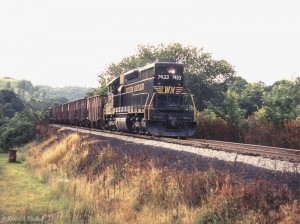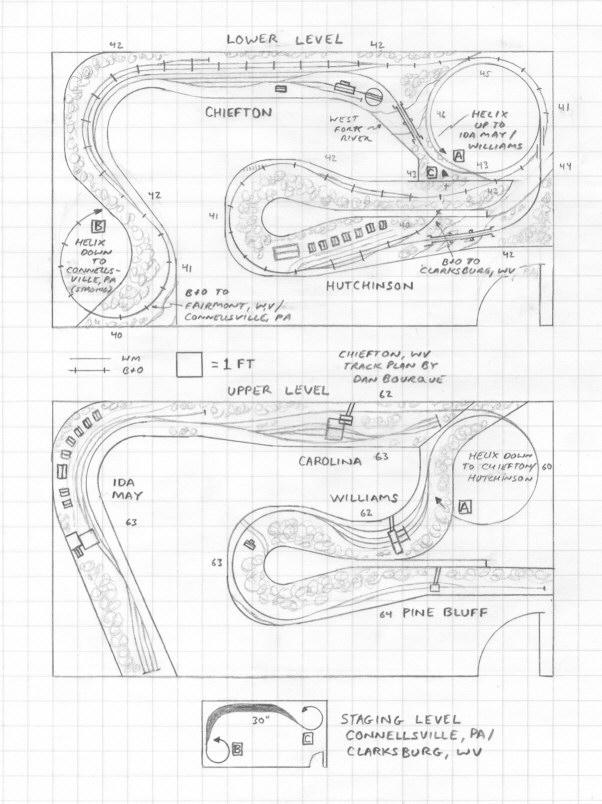- Size: 11′ x 20′
- Scale: HO
- Minimum Radius: 27″
- Minimum Aisle Width: 24″
- Designed by Dan Bourque
 This layout is great for those who like both the Baltimore & Ohio and the Western Maryland pre-Chessie and like a slow pace and lots of switching. The Western Maryland’s coal operations in West Virginia were mostly centered around Elkins, but there was an interesting exception a bit further west. The WM served three small coal branches out of the tiny town of Chiefton, WV. The interesting thing is that the WM main runs nowhere near Chiefton. Instead, the branches were built off the B&O’s line between Clarksburg, WV and Fairmont, WV, part of the B&O’s Monongah Division. The WM reached these branches via trackage rights over the B&O from the connection at Connellsville, PA, more than 50 miles away. The WM abandoned its branches in this area in the late ’60s, but the B&O’s line lasted into the CSX era.
This layout is great for those who like both the Baltimore & Ohio and the Western Maryland pre-Chessie and like a slow pace and lots of switching. The Western Maryland’s coal operations in West Virginia were mostly centered around Elkins, but there was an interesting exception a bit further west. The WM served three small coal branches out of the tiny town of Chiefton, WV. The interesting thing is that the WM main runs nowhere near Chiefton. Instead, the branches were built off the B&O’s line between Clarksburg, WV and Fairmont, WV, part of the B&O’s Monongah Division. The WM reached these branches via trackage rights over the B&O from the connection at Connellsville, PA, more than 50 miles away. The WM abandoned its branches in this area in the late ’60s, but the B&O’s line lasted into the CSX era.
The Layout
This layout captures the WM’s branchlines, the small yard at Chiefton, WV, and the B&O’s line along the West Fork River as they would have appeared in the ’50s or early ’60s. The lower deck represents the B&O main and the WM’s tiny yard at Chiefton. Two short helixes on either end of the mainline connect to a double-ended staging yard representing Clarksburg, WV to the west and Fairmont, WV/Connellsville, PA to the east. The double-ended nature of the staging yard allows for continuous running on the B&O main. The yard at Chiefton consisted of a handful of tracks and a small engine facility including an engine house and turntable. The B&O had a long siding at Chiefton, though it is unclear whether or not it was used as a passing track (why not?). The yard as modeled is simplified but is adequate to handle operations on the rest of the layout. The WM’s branch to Ida May splits from the B&O at Chiefton and immediately crosses the West Fork River. The WM’s branch to Williams and Pine Bluff splits from the B&O at Hutchinson, WV and also crosses the West Fork via a trio of deck truss bridges. The upper deck represents the ends of the short branches where the loaders were. The Ida May line split via a trailing point switch to serve the short Carolina Branch (i.e. trains coming from Chiefton had to back into the Carolina Branch). The branch to Pine Bluff is moderately compressed, but the two tipples on the line are represented.
Though the layout is moderately sized, an entry-level DCC system with an additional booster should be adequate to handle the operations because only a few trains would operate during a session with no more than 2 operating simultaneously. Though the layout has a couple of 24″ wide pinch points in the aisles, there are plenty of “passing sidings” for people where the aisles are generous. Both branches use the same helix to reach the upper level–this simplifies construction and does not pose an operational problem because the same mine run likely served both branches (i.e. only one train would use the helix).
Operations
I do not have a lot of reference material on operations in this area, so this is what I would expect based on the track arrangement and limited information. Operations should keep 2 operators busy for a couple of hours. The focus of operations would be the WM’s mine run out of Chiefton. In latter years, this mine run was handled by a single SD35, but I am not sure whether it ran out of Chiefton or came from Connellsville. To keep things interesting, I would recommend basing the mine run in Chiefton. The session would start with the mine run blocking its train using empties spotted in the yard. The mine run would take its loads bound for Ida May and Carolina and leave Chiefton on the branch. Serving the Ida May and Carolina operations would require dozens of moves to spot the empties on multiple stub tracks, grab the loads and head back to Chiefton. Due to the trailing point nature of Carolina and the facing point nature of Ida May, the mine run might be better off to make two runs from Chiefton, with one being a pushing movement to Ida May. Once these two tipples were served, the mine run would make up its train of empties for Williams and Pine Bluff and head down the B&O to Hutchinson to take the branch. Williams and Pine Bluff are simple arrangements where the mine run could easily drop off emties on the way up the branch and collect loads on the way back down to deliver to Chiefton.
In the meantime, the second operator could run B&O trains from either direction or a WM train out of Connellsville to drop off additional empties. for later in the ops session. Trains would also fill out with eastbound or westbound loads as appropriate before returning to staging–this might require a little sorting in the yard and increase the time needed for each train. There are also a couple of extra tracks on the B&O that could be used for either storage or a team track for the occasional set-out or pick-up by the B&O local. If there’s just one operator, or if the second wants more work to do, the double-ended staging yard would allow a single B&O train to be run multiple times or even continuously to represent additional traffic over the line.
Things I Like About this Plan:
- Complex prototype track arrangement without duck-unders
- Fairly uncompressed
- Two operational railroads
- Continuous running loop
- Nice “entry scene” with the bridges at Hutchinson
Things I Don’t Like About this Plan:
- Narrow aisles
- Complicated track construction near the helix
- Some tough-to-hide track transitions into backdrops
- Lots of curved switches
Related Products:






That’s some interesting history about WM. I was raised in Fairmont, WV, but I never knew of the WM operations south of town. As a kid, I did notice many WM hopper consists being pulled by B&O power, and saw hundreds of them in the yard in Fairmont, but never thought anything about it.
FYI, in the real world, the Carolina/Idamay/Four States mines were about two miles from one another, and were located about 10-15 miles north of Chiefton and Clarksburg in Marion county.
John, glad you learned where those WM hoppers came from! The point you bring up about the mines being 10-15 miles from Chiefton is one of the reason I like double-deck layouts–the helix creates more temporal distance between the scenes, even though they’re stacked on top of each other. That’s tougher to do on a single-deck layout.
I really like this track plan. Anyone could use it to model any main line/branch line interaction. The double ended staging yard for continuous running(re-supply) of hoppers is cool, and the emphasis on locals and switching is spot on. Nice work Dan. I wounder if one could convert it to a single level with hidden staging concept if more space were available?
Jon, because both branch lines come off the front of the benchwork, it wouldn’t be too difficult to have peninsulas for each branch extending into the room and keep this one level. The biggest problem that would cause is a long walk for mainline crews to get around a peninsula to chase their train on the main between Chiefton and Hutchinson.